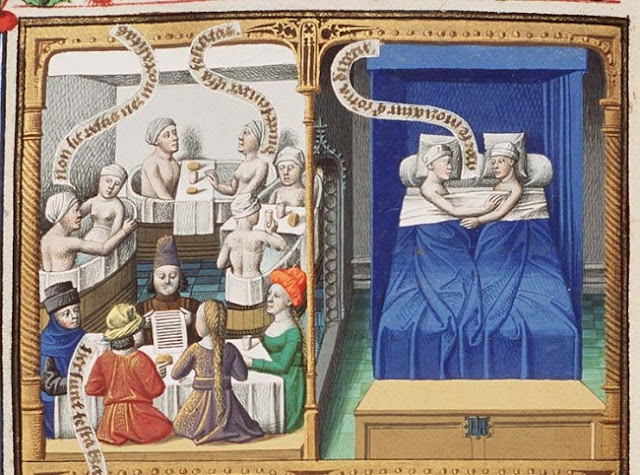Yes, they did bathe. An article at Medievalists explains:
There are stories of how people didn’t bathe in the Middle Ages – for example, St Fintan of Clonenagh was said to take a bath only once a year, just before Easter, for twenty-four years. Meanwhile, the Anglo-Saxons believed that the Vikings were overly concerned with cleanliness since they took a bath once a week. On the other hand, we can also see many literary references and works of art depicting people taking baths, and noting that it was part of daily activity...More at the link.
Some famous bathing sites had their own rules. In 1336, Pietro de Tussignano formulated twelve rules for those coming to the Italian town at Burmi, which lies near Switzerland, to get the healing effects of its bath. They include that the person should beforehand not to have too much sexual intercourse nor have abstained from it, and that he should also enter the bath with an empty stomach (if they had to have food it could only two spoons of raisins with a little wine). You could only pour the water over your head if you were clean-shaven, otherwise your hairs might impede the effects of the water. The person should take the baths for fifteen days, spending up to an hour a day getting washed, but if all goes well, the bather will benefit for over six months with improved health...
Royalty throughout Europe often entertained guests with baths, often trying to impress each other with how luxurious they could make it. This tradition even goes back to the Carolingians - Einhard says that Charlemagne loved taking baths, and that “he would invite not only his sons to bathe with him, but his nobles and friends as well, and occasionally even a crowd of attendants and bodyguards, so that sometimes a hundred men or more would be in the water together.”
...public baths were very common throughout Europe. By the thirteenth-century one could find over 32 bathhouses in Paris; Alexander Neckham, who lived in that city a century earlier, says that he would be awakened in the mornings by people crying in the streets that ‘that baths are hot!” In Southwark, the town on the opposite side of the Thames River from London, a person could choose from 18 hot baths. Even smaller towns would have bathhouses, often connected with the local bakery – the baths could make use of the heat coming from their ovens to help heat their water...
German bath etchings from the fifteenth century often feature the town bathhouse, with a long row of bathing couples eating a meal naked in bathtubs, often several to a tub, with other couples seen smiling in beds in the mid-distance.”

A misconception that probably began by confusing the Middle Ages with the period immediately following up until modern times really. IIRC, this was a period of a few hundred years where water in most of its forms was really feared for various reasonable and unreasonable reasons. The Europeans of these times really were unwashed and filthy, and across all classes.
ReplyDeleteOf course they had baths. Building public thermae to make people favorable to a new emperor or to bribe the local populace to elect some wealthy fellow of senatorial rank to a position as local magistrate was standard operating procedure for the Romans.
ReplyDeleteIntegrate that over a few dozen changes of emperor and hundreds of elections over the centuries of imperial rule and a lot of baths were built in a lot of places.
Well,
ReplyDeleteBig problem
First I am 45 and I have no alergies, born in brazil from french parents and I had no driking water when youg, still I drunk it...
I strongly think that the first years of of a children life are the the most important on the imune system.
Being in contact with microbs, germs or mold (I agree that some mold can be deadly) stimulate your imune system.
BUT what I find the most disturbing is that more and more people are alergic
and in my region, (Québec) I strongly thing that it is due from the insulation materials.
BUT it could be not only from the the insulation materials as we, here in Québec do not all the same, so, the food?
I found a very interestin article: http://www.webmd.com/parenting/d2n-stopping-germs-12/kids-and-dirt-germs
Well I am a bit puzzeld